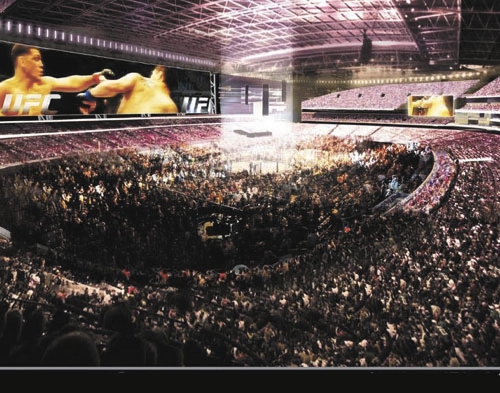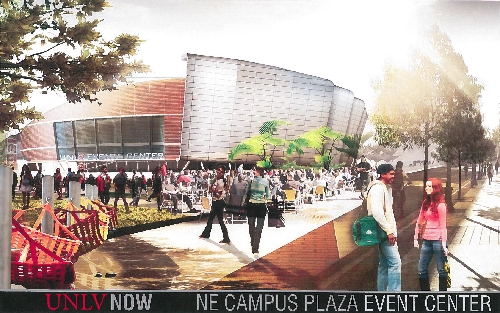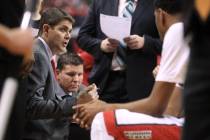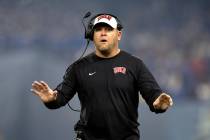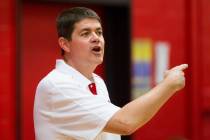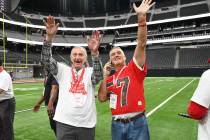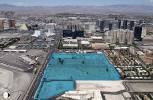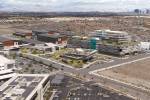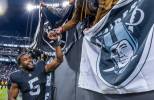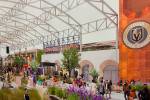UNLV promotes new stadium plan in Q&A
Few public policy subjects evoke a more visceral reaction from taxpayers than use of public dollars to help build a stadium.
Nearly everyone can understand the vital nature of roads and schools and police, but chipping in to build a 60,000-seat domed venue with the world's biggest indoor video screen for events such as college football games, UFC fights, concerts, music festivals and Monster Jams on the UNLV campus?
Well, that's a little too much for some Las Vegans. They argue that creating a tax district on campus to raise public dollars when the Las Vegas Valley is still struggling in the economic doldrums is not good policy.
But the boosters pushing the project say Las Vegas needs a University of Nevada, Las Vegas stadium, or "mega-events center" as they're calling it, to host events that require more than 20,000 seats. Want to play in the entertainment big leagues? Then build it, they argue.
Those boosters include UNLV officials and a private developer, Majestic Realty, who have joined forces to advocate for an $800 million to $900 million complex near Thomas & Mack Center.
UNLV says the mega-events center is the integral piece of a campus redevelopment project dubbed UNLVNow, which includes 2,000 to 3,000 student housing units and 300,000 to 400,000 square feet of retail Majestic would build and operate on campus land.
Another aspect of the project that sets the UNLV plan apart from other sports facility deals around the United States is the absence of a professional sports team as the anchor tenant. There are few comparable deals anywhere.
Those leading the project - Don Snyder for UNLV and Craig Cavileer for Majestic - cite an economic impact study by a University of Michigan consultant who determined that the stadium would attract 15 new events each year, bringing in $393 million in new spending. Snyder, a former banking and gaming executive who is now dean of UNLV's hotel administration college, has two go-to descriptions for the proposal: "game-changer" and "next big thing."
But opponents doubt the economic impact numbers and express concern about potential traffic congestion and parking woes.
Then there's the question of who should pay. Stadium projects like this are called public-private partnerships, but the public usually shoulders most of the cost - $2 for each "private" $1.
To help pay for the stadium, UNLV has asked Assembly Speaker Marilyn Kirkpatrick to assist with legislation that would allow a campus-area tax district to capture revenue from food, beverage and retail sales. UNLV and Majestic are still negotiating the stadium deal, which will split construction costs and determine how much each will receive from moneymakers such as sale of naming rights and suites. The Board of Regents is to see those numbers on Feb. 28.
To help set the stage for next month's big disclosure, the Review-Journal asked UNLV to answer written questions about several aspects of the plan:
QUESTION: The proposed tax-increment financing district is supposed to generate tax income from future retail development on campus to help pay for the events center construction. What if revenues fall short of projections? Will the state, UNLV or taxpayers have to make up the difference? What language will be built into the agreement with Majestic Realty to safeguard ... taxpayers from being strapped with a debt? Will the TIF District revenue be the sole source of the public financial contribution toward the construction of the facility? Will there be a public board representing any new TIF district? If yes, what parts of the community will be represented on the board?
ANSWER: The Nevada System of Higher Education Board of Regents-approved exclusive negotiating agreement with Majestic Realty in June 2012 defines a process of approvals for the UNLVNow project that involves many steps. The purpose of this process is to help ensure we methodically review all details of each aspect of the project and bring these forward for (Regent) approval, and to be prudent in our understanding of the financial and other obligations and risks.
UNLV is currently negotiating with private partner Majestic Realty on basic economic terms for the mega-events center. ... The estimated all-in project costs and business and financing assumptions for the mega-events center and related infrastructure are also planned to be presented at this meeting.
While we do not have a final agreement at this time, Majestic is an at-risk developer for the mega-events center and student village. There would be no financial risk to UNLV for the mega-events center as Majestic would be responsible for any construction and operational cost overruns. The (Regents) and UNLV would be protected and the public financing would be non-recourse, meaning if the public revenue streams are not sufficient to pay the debt there is no recourse for investors. The private debt component of the facility financing would be limited to the operations of the facility. Thus, in total, (Regents) and UNLV would be protected.
In addition, we are assuming full protection for any cost surprises on the construction. For the mega-events center we will require an approved budget/financial plan by (Regents) before the project proceeds (with independent review of financial plan), along with a (Regent)-approved ground lease (with any/all protections/requirements). We will also require 100 percent construction drawings and all approvals and a guaranteed maximum price before starting construction on the mega-events center. Majestic would have full responsibility for the financing, construction and operation of the student village, and again under an approved ground lease by the (Regents).
The tax district would, as proposed, capture revenue from all activities of UNLVNow. If a tax district is presented and approved by the Nevada Legislature to support the UNLV project, we expect a public board to be established. ... We have made proposals for this bill and the structure of the "authority" that would manage it, but it will require legislative review to determine if any of these proposals are supported.
Q: Majestic Realty will be building the student housing and retail space as part of the new Student Village. What happens if Majestic halts construction in the middle of the Student Village project? What safeguards will there be in the UNLV-Majestic agreement to make sure Majestic will properly maintain the new student housing it builds?
A: Current planning is focused on the mega-events center, for which an operating model and basic economic terms agreement are expected to be presented to the Board at its Feb. 28/March 1 meeting. We expect that additional planning for the student village component, including business terms, will begin after more details on the mega-events center are solidified. It should be noted that all future planning and prospective business terms regarding the student village will first be presented to the Board of Regents for approval.
If the student village moves forward we would follow our existing plan (which is defined in the exclusive negotiation agreement) and methodically negotiate the business terms for this project, which would include protections for UNLV to assure we do not have any financial liability for the project, and to assure that there is protection for the completion of the project.
Q: UNLV President Neal Smatresk told the Review-Journal that a team of 15 consultants, lawyers, bond counsel and staff has been assembled to work on this mega-events center project. Who are the members of this team and what are the payments/hourly rates for the consultants/non-staffers?
A: Many of the individuals working on this project are current University and/or Majestic employees. Majestic has hired a number of consultants and UNLV has hired some as well. A list of the UNLV consultants and their compensation will be included in the final project cost estimate provided to the (Regents on) Feb. 22. ...
Per our agreement with Majestic, they have provided us with $425,000 to help address our direct costs in supporting the project, and we expect to recover any additional pursuit costs from the project financing (if it moves forward).
UNLV has created a board of community leaders who serve as unpaid volunteers and are actively consulting on the business and financial issues, and other components of the UNLVNow project. The development advisory board is chaired by Mark Fine and includes John Midby, Irwin Molasky, Ted Quirk, John O'Reilly and Rich Worthington.
Q: What specific new road improvements will be done to accommodate the new facility? Where will cars be parked for the new events center?
A: Efficient access and parking availability are important components of the project, as is improved transit to support the mega-events center. Through the campus' master planning efforts that were approved in December by the (Regents), the traffic, transportation and parking requirements of the entire UNLV Maryland Campus were studied.
We have worked closely with the County and outside consultants on potential traffic and transportation issues. Majestic hired a well-known local consultant to look at the traffic and transportation issues, and we have incorporated their recommendations in our cost assumptions for the project. In addition to many intersection improvements around and inside the campus, we assume a strong partnership with RTC for use of Harmon as a transit corridor to move individuals to and from the mega-events center.
The campus parking plan is based on a "distributed" model so that we do not rely on one major way in and out of the campus (Harmon Avenue), but have parking structures around the campus, all within short walks of the mega-events center, so that those driving will be directed to the most convenient garage. Solutions from the master plan, part of which would be included in the all-in costs for the mega-events center project, include continued conversion of parking from surface to structured parking and coordination with other modes of transit (bus, bicycle, pedestrian, other).
Currently there are more than 12,000 parking spaces on the campus to support academic needs and balanced against events in the Thomas & Mack Center. The plan ... is to move this total number of parking spaces up to 23,500, and manage the events in similar ways to ... activities in the TMC.
Distributed access to campus parking will relieve congestion at specific entry points, but will also support campus parking efforts during the academic week. The student village will have dedicated parking as outlined in the campus master plan. (At www.unlv.edu/assets/masterplan/docs/2012-UNLV-Master-Plan-
Update-Board-Presentation-MJ-111612.pdf)
Q: To what extent is UNLV counting on revenue from this to fund sports and other university programs?
A: UNLVNow is a game changer for the university and the community - it will better connect the campus to the community and the tourism industry by bringing signature events year-round and returning all of UNLV's athletics programs to campus. The mega-events center would, like the Thomas & Mack Center, serve as a community asset, benefiting the university in the process. Any revenues UNLV enjoys from the mega-events center's operations will also enhance the campus' academic programs and activities.
While these additional funds would significantly benefit the university and its programs, they are estimates and cannot be "counted" as a revenue stream. According to an economic impact report conducted by the University of Michigan Center for Sport Management, the mega-events center would have more positive economic impact than all the LVE (Las Vegas Events, a company that produces and promotes events in Las Vegas) events now do on an annual basis.
Q: The Legislature convenes Feb. 4 and Regents are to vote on the mega-events center on Feb. 28. Why wasn't a final agreement in place before the session, and will there be enough time in the session to accommodate enabling legislation for the TIF district?
A: The UNLVNow project is a very large and complex undertaking. ... To reach a final agreement on a contract, one needs to know the design/function of the facility, its estimated cost and be balanced against a feasible financing plan that can make it a reality. Most public/private partnerships take some time in order to balance these factors and be able to finalize an approach that is financially feasible and also acceptable to the public that will be supporting a portion of the costs. We have been working with legislative leaders for several months and are in the process of drafting a bill to create the tax increment district. We believe that our current schedule will allow sufficient time to work to complete the tax increment district bill and educate legislators regarding its benefits ...
Q: What happens to Sam Boyd Stadium if the new facility is built? How much will it cost to relocate the baseball field and other athletic fields?
A: There is no final plan on the disposition of Sam Boyd Stadium. ... Relocating baseball fields was covered in the master plan presentation so it is considered to be part of the project cost and will be part of the final project cost presented to the (Regents).
Contact reporter Alan Snel at asnel@reviewjournal.com or 702-387-5273.
2012 UNLV Master Plan (7 MB)
UNLVNow Proposal
UNLV Stadium Parking



